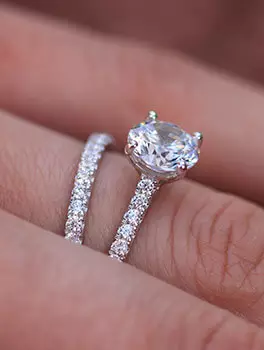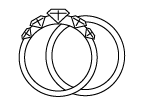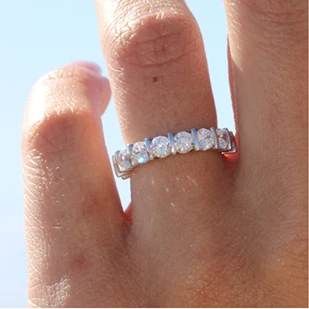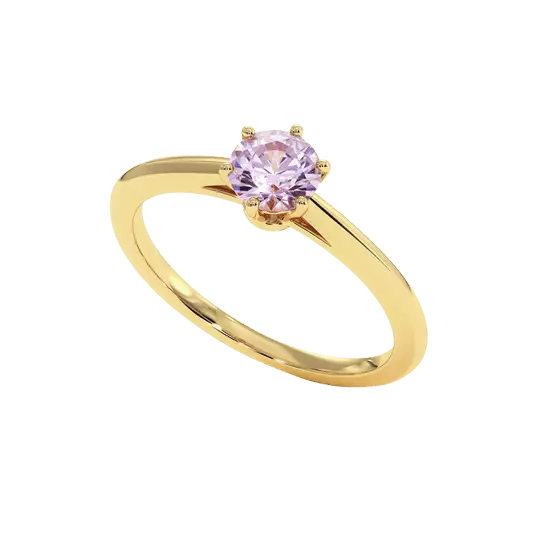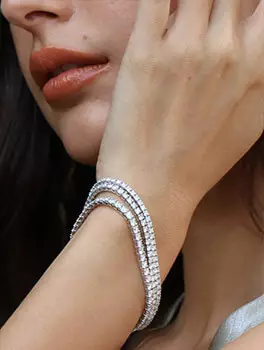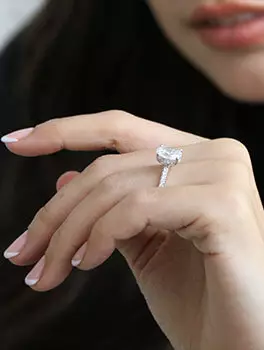WHAT IS RHODIUM PLATING?

Rhodium plating is a process used on silver and white gold jewelry. This process allows the jewelry to regain its intense white color, returning it to its original state at the time of its creation, like new!
Rhodium plating is done thanks to rhodium, which is an element found in nature. Yes, even in the history of jewelry and diamonds, physics and chemistry are important aspects.
What is rhodium?
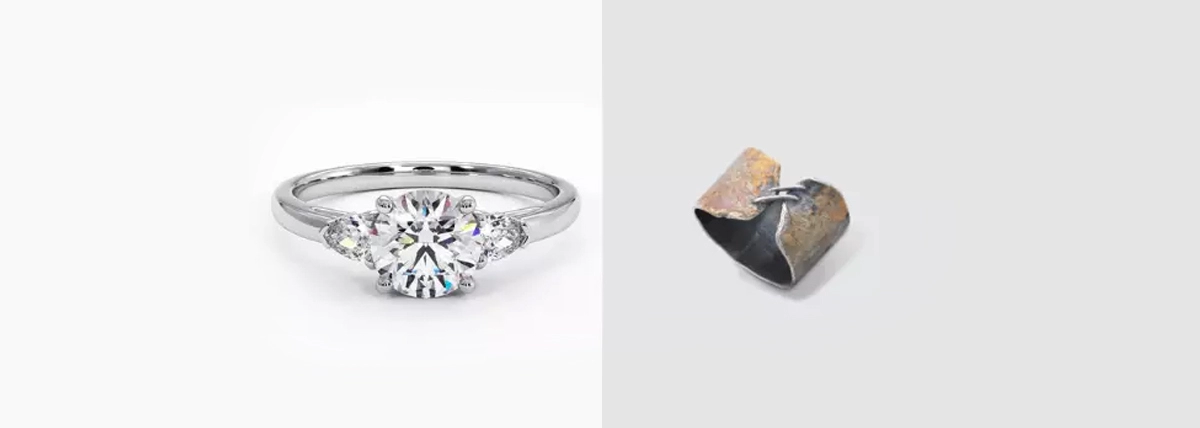
Rhodium was discovered in the early 19th century by the English chemist William Hyde Wollaston. (Fun fact: this chemist is also responsible for the discovery of palladium). Rhodium is a precious white metal, it corresponds to the chemical symbol Rh.
The word rhodium comes from the Greek word rhodon which means rose. Why was it called rose? Because it was named after the pink color of rhodium compounds. Rhodium, like ruthenium and palladium, belongs to the family of light metals in the platinum group. This group of metals includes 3 heavy metals: iridium, osmium, and platinum. (Fun fact: the platinum family and its set of included metals are called PGM - Platinum Group Metals).
Rhodium is known for its durability, electrical conductivity, chemical stability, and high hardness. Rhodium is also a noble metal. Its melting point is very high, for comparison: gold melts at 1063°C while rhodium melts at 1964°C. Finally, rhodium dissolves very slightly in the strongest acids.
Each year, about twenty tons of rhodium are produced. It is an extremely expensive element, it is more expensive than gold. Rhodium is silver-white in color. The most important thing to know about rhodium is that it is rustproof at room temperature and does not tarnish over time. It is the perfect element for a piece of jewelry's life.
Rhodium is mainly found in nature in its raw form. The earth's crust contains only 0.001 ppm of rhodium. It is always composed of a stable isotope and is always found with other platinum group metals (PGM).
The largest rhodium mines are located in South Africa and in the Ural Mountains. There are other less important deposits in South America or in Canada.
Indeed, a piece of jewelry must be rustproof and should not tarnish over time. It should reproduce the natural characteristics of rhodium. This is why rhodium is used to protect jewelry from the obstacles of life.
What is the use of rhodium plating on a diamond jewelry?
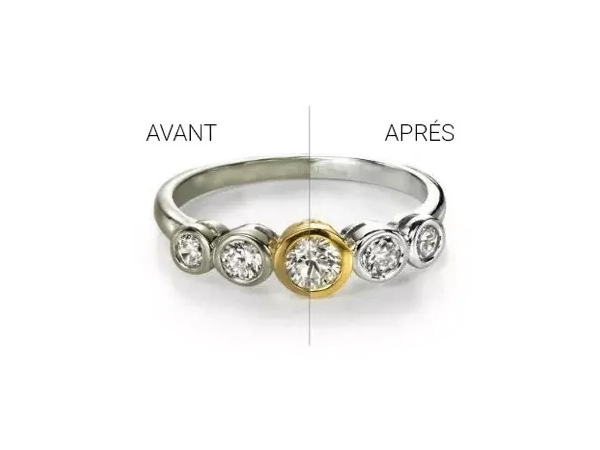
As you have understood, rhodium plating is the source of the shine of silver and white gold jewelry. In principle, rhodium plating is preceded by a polishing of the jewelry. Polishing consists of making the surface of the jewelry shinier, it helps to smooth out roughness and remove micro-scratches. It is therefore preferable to carry out a polishing before a rhodium plating.
If you own a diamond, white gold or silver ring, this beautiful piece of jewelry is subject to the contact of daily life. So if you want to restore its original shine, the jeweler or diamond dealer will first proceed with a polishing and then a rhodium plating. If the polishing step is not done, the final result will not be as resplendent as with this step. Moreover, if the polishing is done, the rhodium plating will adhere better to the jewelry, thus its effects will last longer on the ring. Be aware, it is important to understand that the polishing step will not in any way alter the characteristics of the ring (weight, appearance...).
So rhodium plating gives a whiter shine even on white gold, because in its natural state, it is slightly yellow. Rhodium is an unalterable metal that allows silver jewelry to retain their color while giving them a brighter and whiter shine than classic silver jewelry. (Fun fact: silver is naturally oxidizable and over time, it tarnishes. Rhodium plating is done to prevent this from happening.)
What is the rhodium plating process? And what is the result?
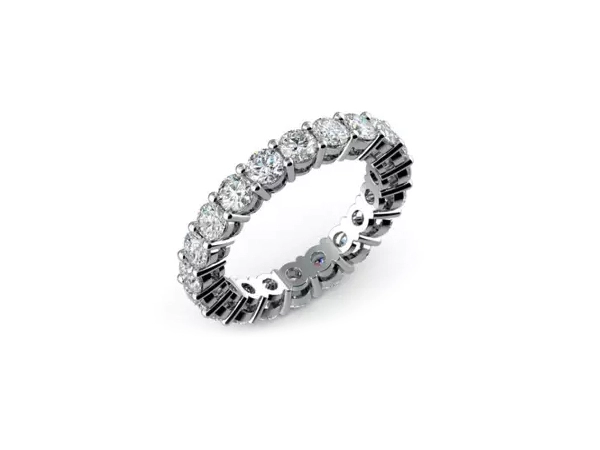
Once the polishing step is completed, it's time to move on to the rhodium plating step. How does this work? It's a process dictated by defined steps with a specific time to be respected for each of them. Therefore, it is preferable to call on a professional for rhodium plating.
The time required for each step can nevertheless vary depending on the intensity of the rhodium plating preferable for this jewel. For example, if the jewel requires strong rhodium plating because it has a tarnished color (the quality of Celinni jewelry is very good, so they will never be in such a state!), then the rhodium plating will certainly have to last longer.
Before starting the rhodium plating, the diamond jewelry is dipped in an ultrasonic bath. This little bath will eliminate all the small residues that can settle in the small areas of the jewelry during polishing. Polishing requires the use of brushes
which are passed in pastes aiming to improve the quality of the polishing. These pastes can then leave black residues that the ultrasonic bath will eliminate.
The cleanliness of the jewelry is imperative before moving on to the rhodium plating stage. For the rhodium plating, the jewelry will be dipped in four successive baths. It will then be degreased, rinsed with running water and with demineralized water before finally going into the rhodium bath.
The results of rhodium plating depend on various factors, the main ones being:
- The presence of certain impurities
- Agitation
- Current density
- The acid content of the bath
- The temperature of the bath
- The concentration of rhodium in the bath
It's a real chemistry experiment, but that's what we need for a dazzling result!
During its last bath, the magic of rhodium takes place, the incredible color of the jewel will be revealed and thus the jewel will be like new! This maintenance is of high quality, don't forget that it's a material that costs more than gold. But with this process, you will have the guarantee of finding your jewel as on the first day.
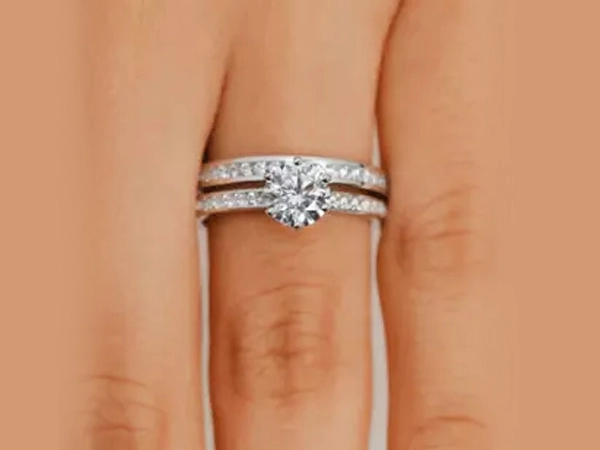
Are there substitutes for rhodium plating for diamond jewelry?
The power of rhodium plating allows to change the appearance of jewelry and make the surface more resistant to degradation. It is also useful for people who are allergic to certain metals.
Apart from rhodium, the elements that can substitute it are palladium, ruthenium and platinum. If you notice well, these are elements that belong to the same family. Indeed, the periodic classification is made in such a way that similar elements belong to the same family.

- The lifespan of a rhodium layer depends on its thickness and the care given to the jewel: 1 year, 2 years, sometimes more.
- Paul McCartney received a special award from the Guinness World Records book in 1979 to reward his musical career. But gold, silver or platinum were not good enough for this occasion. Paul McCartney then received a rhodium disc! (Fun fact: it is actually a gold disc plated with rhodium)
- The color of rhodium is close to that of silver and therefore also to the color of white gold. After various tests with different metals, it turns out that only rhodium does not alter the color of silver or white gold. Even if it offers a slight gray tint. That's why we use rhodium to bring out the shine of the first day
The diamond dealer's advice:
Rhodium plating is a jewelry maintenance step, it requires time, patience, and rigor.
- The layer of rhodium still deteriorates with friction and shocks. We therefore advise you to regularly apply a new layer of rhodium after polishing
- Do not carry out the rhodium plating process alone, ask your diamond dealer who will take care of this delicate step
- Rhodium plating is relatively affordable, it will depend on the jewelry
Congratulations! You now know everything about rhodium plating, do not hesitate to contact us for more information on this delicate step.








NEWSLETTER
Sign up to receive the latest news regarding
the products and services CELINNI, and much more.





















